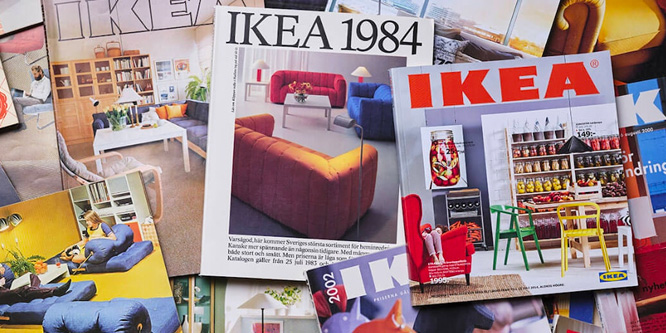
Photo: IKEA
December 8, 2020
Is IKEA making a dumb mistake ending its catalog?
The year 2020 is the last year that IKEA will publish its big catalog. The publication, which was first printed in Sweden in 1951, is no longer seen as necessary to the furniture giant’s marketing efforts as more and more people seek out what they want online.
Konrad Grüss, managing director, Inter IKEA Systems B.V., said that many people inside and outside of the company have an emotional connection to the catalog, but that it was the right time to end its publication.
“Turning the page with our beloved catalog is in fact a natural process since media consumption and customer behaviors have changed. In order to reach and interact with the many people, we will keep inspiring with our home furnishing solutions in new ways,” he said.
Mr. Grüss said IKEA is ready to meet consumers where they will be most receptive.
“We are not starting from scratch,” he said. “We have been transforming many aspects of how to reach and interact with our customers, and the work continues to find new ways to amplify unique IKEA home furnishing knowledge, products and solutions in the best possible way — to inspire the many people through new ways, channels and formats.”
The furniture giant has seen a larger percentage of customers buying its products online rather than go shopping in its massive warehouse locations. The retailer reported that its worldwide online sales jumped 45 percent last year and that IKEA.com had over four billion visits. The company has introduced site and app enhancements to further enhance digital performance.
IKEA’s decision to end its voluminous publication puts it among a list of other retailers, including H&M and REI, that have cut back or ditched big catalogs in recent years for other print and/or digital alternatives. In the case of IKEA, the retailer will still publish a smaller book next year, just not the big catalog that people in dozens of countries have come to know.
Discussion Questions
DISCUSSION QUESTIONS: Is IKEA making a smart move by no longer publishing its big catalog or is it a dumb mistake? Do you still see a role for retailer published catalogs at this time in history?
Poll
BrainTrust
Mohamed Amer, PhD
CEO & Strategic Board Advisor, Strategy Doctor
Gary Sankary
Retail Industry Strategy, Esri
Carlos Arámbula
Principal, Growth Genie Partners
Recent Discussions







Some people thought having customers build their own furniture was a dumb idea too – it turned out well for IKEA. I think this is a smart move and the right time. Not only are consumers moving to online like never before, but a reduction in the environmental impact of paper and distribution of catalogs is a significant benefit. While there still is a place for catalogs, I do see this diminishing over time, as access to information online makes the traditional catalog obsolete.
Great point Mark! Similarly, 10 years ago some people believed that paper books and paper newspapers would be soon gone. And yet they are holding their ground — even among the younger generations. It will be interesting to see how the content of IKEA’s smaller (paper) book will evolve, and how many customers will request it.
Given the number of catalogs IKEA produces, it is an expensive exercise that is not particularly environmentally friendly. So, in that respect, ditching the catalog is a sound decision. Of course there will be some consumers who are upset by the action. However the fact is more and more IKEA shoppers are migrating to exploring products online, and by using tools like augmented reality or using room planners. The explosion of these methods makes the catalog less necessary than it was in the past.
Printed catalogs have been discontinued by most every retailer, so this is no surprise. While there is still a segment of consumers that love to browse through print catalogs and fold corners to mark the pages with items they want or like, this segment is declining. This decision is primarily cost based, as these catalogs are expensive to produce, print and mail. One option that some retailers may consider is to print catalogs in limited quantities and charge customers for the catalogs. I suspect there are still quite a few people that would purchase the catalogs.
I might take this one step further and allow customers to opt in for the catalog and IKEA can send it on demand. No charge! For my 2 cents.
Another option would be to charge $5 and provide a $5 coupon for their next order. That way it is essentially free for the customer and IKEA covers their cost either with the $5 fee or the future purchases made with the coupon.
It may be that there’s a substantial fixed cost — staging and filming hundred of items probably isn’t cheap — and the prospective demand is too small to justify amortizing the cost. $5 is nominal, but if it ends up being $25 or $30, it would probably set up a cycle of ever smaller demand/ever higher unit cost.
They’ll still be staging and filming the items; if anything at a faster pace as online selling requires additional angles and even video. So there’s no cost reduction in that respect.
From my own experience with publishing catalogs, the fixed costs for printing setup are the real hurdle, as is the ever-increasing cost of paper stock (as consolidation in that industry has shuttered mills in order to create scarcity – something the Biden Administration should look into).
Also even with common keycoding and matchback practices, it has gotten harder and harder to attribute sales dollars to print vehicles, especially with Amazon’s rise (not IKEA’s problem there but one for the rest of us.)
So whereas 10 years ago I was regularly dropping a million catalogs to teachers, this year I may well conclude it isn’t worth it at all. My biggest complainers who call in? Amish and Mennonite home-school families – and there aren’t enough of them to justify the fixed cost of production. Gen Z and Millennial teachers could care less.
It will be fascinating to see what happens. Personally I feel this leaves an opportunity for someone to differentiate themselves with a paper catalogue of some kind. There are all sorts of disadvantages of a printed catalogue but flicking through for ideas is never the same electronically as it is on paper.
Digital natives no longer desire a paper book to shop. They want experiences. Interestingly, IKEA was one of the early pioneers of “shoppable media.” They took television ads and converted them to interactive and “living” catalogs.
They did this too with static images. One of them was a promotion to sell furnishings from popular TV culture – the living room set from Friends, or Stranger Things. I covered part of that campaign here.
I’m finding it a bit hard to let go of my own attachment to the IKEA catalogue. I also read a newspaper, yes I’m a dinosaur.
IKEA has the data to know what the impact of the catalogue is on their business, I’m sure they’ve analyzed this quite thoroughly. When you also add in that they have built a brand position around sustainability, eliminating the catalogue is the right thing to do. Mark Ryski has already pointed out this morning, at one time we thought building furniture at home was a dumb idea. There are better digital options available to give people a browsing experience with IKEA products.
Print catalogs are a thing of the past due to changes in shopping behavior, environmental concerns, speed to execute, and inability to adjust once printed. It turns out that the internet offers a much better, more informative version of this relic at a lower cost. A lot of retailers have proven that a shift from catalog to digital can be really effective (one example being Littlewoods in the U.K.). Retail, like many other industries, requires adaptation for survival. Montgomery Ward was innovative for its time and is even credited with creating Rudolph the Red-Nosed Reindeer for its holiday campaign. The kids are still singing the song, but the retailer didn’t adapt and others are now profiting off of it.
Sending a massive catalog does not provide a good experience, but sending targeted catalogs is still smart and has a good ROI. The lead times for catalog design, printing and circulation are pretty long. But sending ahead of major seasons – summer and holidays – works great in my experience.
It is important to remember that catalog is one of the channels and could be a good reinforcement. The effectiveness needs to be measured in conjunction with email marketing and digital advertising. It’s not easy, but it’s achievable — particularly for larger enterprises.
Suresh, great thought and comment. From working in catalog retail, my experience would make the comment spot on!
Great question with more than one answer. A number of retailers are collaborating to send out catalogs together. Other retailers which traditionally have sent out great catalogs, and are known for them, continue (successfully) to send out catalogs. Still others have discontinued their catalogs. There is no pat answer. It works for some and not for others but the decision is a gamble.
IKEA has shown remarkable steps when it comes to sustainability and digital innovation. I think removing their catalog is just part in parcel of these steps (printing less paper and catering to online shoppers – after all, you can still find all their catalogs throughout history on their website). Some may think their catalogs define the brand’s legacy, but removing them shows that IKEA can still be a brand with a legacy while being both flexible and disruptive. This is the kind of strategy that will mark leading brands in the future.
Print catalogs are an expensive method for bringing the store to a consumer’s home. They were an innovation a hundred years ago, ideal fifty years later, and are out of favor today. In the future, print catalogs will be more of a fill-in niche campaign targeted with high precision to the right customer and with a personalized range of products.
The internet has revolutionized how we discover products and make purchases. It has eliminated the obstacle of physical distances, and technological advances make the fidelity of on-screen images and colors comparable to high-quality photography of a catalog. Additionally, while a print catalog is out-of-date as soon as it’s printed, a website is dynamic and engaging.
I expect print catalogs to continue to have a role, albeit diminishing, in marketing campaigns, but with significantly greater precision and forethought. The days of massive catalogs — in size, uniformity, and mailing — are history.
Catalogs are becoming the dinosaur of a previous retail generation. People are buying online more and more, and the catalog is a stagnant picture of the products put together by IKEA once annually. In today’s rapidly changing world, IKEA can be much more responsive to its customers with online description and sale of products. Retailer published catalogs will still work if the catalog is smaller and reflects the slower evolving products. However their role will continue to diminish over time.
I understand this is a rational decision based on expense, data and outcomes. (And maybe I should leave it there.) But the big IKEA catalog has been part of its brand identity since its beginnings, and functioned as an “idea book” for consumers at least as much as a vehicle for selling product. Maybe a smaller catalog — with scannable QR codes linked to the website — can still be part of an overall marketing program.
Unfortunately, digital acceleration has made the holiday catalog and IKEA catalogs a relic of another age. While it’s challenging to replicate the multisensory experience associated with a physical catalog, the environmental impacts and costs of producing these have become very significant.
Perhaps IKEA and other brands could offer up these physical catalogs by subscription service for those nostalgic consumers for a nominal fee. That way the company could curate the distribution of these and avoid mass-producing catalogs that most customers no longer need.
I don’t think so — the paper catalog as support for shopping was due for recycling. That said, IKEA could really step up its game on the website with better search, visuals, and add in some mix of VR. All the technology to do so is readily available — the shopper experience on their website could use a refresh.
It makes sense – with so many customers shopping online the physical catalog becomes less valuable. Since eliminating it also reduces their environmental impact, it seems like a win-win.
Given the economics and environmental concerns, this decision makes sense, despite some customer pushback. Decisions like this are analogous to a company’s decision process to invest in legacy brands. While there is always emotion surrounding such decisions, I recommend asking one question: if you were making a decision to launch this product or in this case, publish a printed catalog, what decision would you make? I doubt IKEA would launch a paper catalog.
Although to me personally a catalog is completely irrelevant, what was the circulation on this catalog and did they have some way of tracking who ordered from it, etc.?
It may be a better idea to move to a catalog by request model for another year or two before completely stopping this.
I seldom question the decisions companies make — who knows more about their business (hint: it’s not I) — and I won’t here. It may end up being a mistake, but it won’t be a “dumb” one.
That having been said, I wouldn’t apply this decision too broadly: not all product categories respond the same to catalogues. Furniture doesn’t strike me as one of the more responsive ones, since people will most certainly want to see the product in person, but there are many (clothes, gadgets) for which they’re well suited. And for the many retailers who are trying to get attention — who would otherwise go unnoticed by most of us — a well done catalogue arriving in the mail at the right time can be the difference between finding a customer for life, and being a ship that passed in the night.
It’s a smart move that should’ve been made years ago.
The shopping and buying behavior of IKEA’s starter-furniture target demo has evolved beyond the tangible catalogue. What was once an effective tool is now as relevant as phone books, and the resources should be spent on enhancing online shopping and customer service options.
Smart move at the right time. The catalogs were more for inspiration things to pick up when you visit the store, not actual product browsing (you go online for that). They have too many SKUs to print in a catalog effectively and if I need something, a good mobile app and online takes care of it. Switching it to an inspirational book next year when the stores reopen to inspire people to redecorate makes a lot more sense.
Print catalogs are no longer the needed resource they once were. More and more customers are reading and shopping online and with today’s technology, they are able to implement more features into the product’s page. For example, where once you could only see a product on a catalog page, you can now use AR to see how that same product would look in your actual house.
This is the right move for IKEA, and I think we’ll see more and more retailers doing the same.